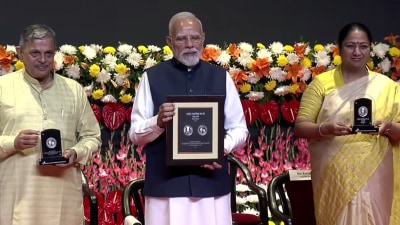Hammer or sickle?
CPM’s Central Committee blames alliance with UPA and UPA’s policies, particularly those on inflation, for the panchayat election outcome.

CPM’s Central Committee blames alliance with UPA and UPA’s policies, particularly those on inflation, for the panchayat election outcome. But there’s also recognition that industrialisation and related land acquisition policies are responsible. Before deducing this is a pointer to the next parliamentary elections, one has to be careful. Left Front has still won 13 out of 17 districts (zila parishads), down from 15 in 2003. It lost East Midnapore (Nandigram is there), Hooghly (where Singur is and where DLF proposes to set up a township in Dankuni), South 24 Parganas (where the Salim group expects to set up an SEZ) and North Dinajpur. This can’t be a referendum on industrialisation, though in the course of campaigning, the CM himself suggested the elections were such a referendum. It can be interpreted as a referendum on land acquisition, but this isn’t the same as a referendum on industrialisation. There hasn’t been any overall loss in districts like West Midnapore, Bankura, Bardhaman and Purulia, where too there has been industrialisation. And what do we mean by opposition to land acquisition? At one level, there can’t be opposition to land acquisition. There can be objection to quantum of compensation paid. All land can be acquired at a price.
The only place where land was directly acquired for a specific industrial project was Singur. There wasn’t any actual acquiring in East Midnapore, Dankuni or South 24 Parganas, though, had opposition not blown up, there would eventually have been such acquisition. Hence, there is also a difference between resistance to quantum of compensation in a specific instance and a more intangible opposition to a general process that is perceived to be authoritarian and high-handed. Thanks to an antediluvian and colonial Land Acquisition Act of 1894 and complicated processes and delays, including a stipulation that future increase in land prices can’t be factored into compensation calculations, the process has always been authoritarian. Left Front did fairly well in Assembly elections in 2006. Therefore, there doesn’t seem to be any continuous trend towards Left Front’s diminished popularity, a factor that is pertinent if one extrapolates to general elections in 2009. Nor is the alternative to Left Front a credible one, there is a TINA (there is no alternative) phenomenon there. Arguments about rigging elections don’t quite wash. Of course, there is rigging in West Bengal, as there is in other parts of the country too. But that doesn’t explain Left Front’s continued success for more than 30 years.
In other words, if panchayat elections outcomes are more than a flash in the pan and are interpreted as signifying diminished Left support in a long-term sense, one must look for discontinuities, or sudden changes. There hasn’t been any continuous decline in support. That base, moving away from the original industrial belt of trade union support, has traditionally been rural, facilitated by land reforms. These land reforms meant the Bengal Land Holding Revenue Act of 1979 and 1980 Revenue Rules, popularly known as Operation Barga. Several years down the line, this created problems for any land acquisition and compensation, because it created three classes of rural households — land-owners, bargardars (sharecroppers) regularised in 1979/80 and bargadars issued temporary certificates without regularisation. Temporary certificates are good for the political process. They are both carrots and sticks for ensuring voting for the Left in elections. Once sharecroppers are permanently regularised, one doesn’t have any clout over them. Land-owners don’t object to land acquisition resulting from industrialisation. They got nothing under Operation Barga, not even due rents. With all its warts and blemishes, they get something under compensation. So objection to land acquisition comes from regularised sharecroppers and irregular ones, especially the latter, where there are legal recognition problems too.
There is some evidence (depending on variable) of West Bengal’s agricultural performance having improved after these rural reforms (including decentralisation through panchayats). The social empowering effect was stronger and probably largely explains support for Left. For some odd reason, people refuse to accept that West Bengal’s record of SDP (state domestic product) growth has been good for two and a half decades and has been better since 1991. Notwithstanding the present CM, West Bengal will rarely be mentioned in the same breath as Karnataka. There will be allegations about the doctoring of data, an argument that shouldn’t be taken seriously. However, this growth has been agricultural-driven. There was zero manufacturing and little service sector growth. Why did West Bengal suddenly wake up to benefits of industrial growth, investment (domestic and foreign) and IT towards the fag end of the 1990s? This marginally pre-dates Buddhadeb Bhattacharya becoming CM in 2000, so such trends can’t be attributed to him. Why is agriculture portfolio now the bastion of allies rather than CPM? Why do RSP and Forward Bloc, rather than CPM, complain about anti-people policies following industrialisation? The answers have a lot to do with West Bengal’s social and economic change.
A subsequent generation of CPM leadership and cadres emerged in the second half of the 1990s. This wasn’t a segment that believed in rural Arcadia, they wanted to opt out of agriculture. Meanwhile, there was the factor of educated unemployment. Government jobs were controlled by the party, but these weren’t enough of a vent. Graduate employment was ensured through the private tuition system, a de facto privatisation of education relatively unrecognised and under-researched. When West Bengal government decides to ban private tuition by government school teachers, the motivation is survival of this class, not improvement of government schools. However, because of splintering in support base and emergence of a relatively richer segment in leadership and cadres, this was no longer an acceptable outlet for unemployment either. In addition, even before large-ticket (domestic and foreign) investments materialised, small-scale business and entrepreneurship emerged. At a superficial level, one hears of arrogance and high-handedness by cadres, especially in the context of incidents like Nandigram. One is told they alienated the support base and the centralised party had little control over them. While this is true, reasons are fundamentally economic.
This wasn’t learning from Chinese reforms. The perestroika was internal and the glasnost, meaning implosion in party from within, was also internal. The forces behind turmoil and churning aren’t going to go away. That’s the reason the objective of industrialisation won’t disappear. Nor will the problem of land acquisition. CPM didn’t consciously create this cleft stick. However, it is caught in it and there is no stepmother at the Centre or American imperialism to blame.
The writer is a noted economist bdebroy@gmail.com



- 01
- 02
- 03
- 04
- 05




























